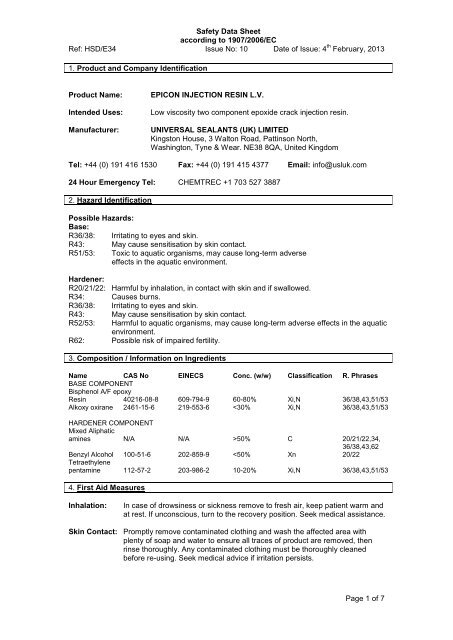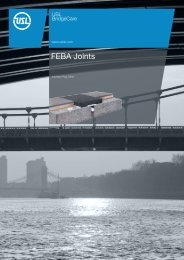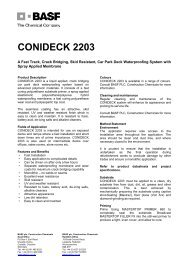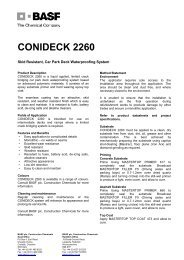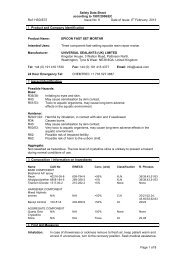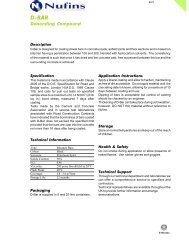Download - Universal Sealants
Download - Universal Sealants
Download - Universal Sealants
Create successful ePaper yourself
Turn your PDF publications into a flip-book with our unique Google optimized e-Paper software.
Safety Data Sheet<br />
according to 1907/2006/EC<br />
Ref: HSD/E34 Issue No: 10 Date of Issue: 4 th February, 2013<br />
1. Product and Company Identification<br />
Product Name:<br />
Intended Uses:<br />
Manufacturer:<br />
EPICON INJECTION RESIN L.V.<br />
Low viscosity two component epoxide crack injection resin.<br />
UNIVERSAL SEALANTS (UK) LIMITED<br />
Kingston House, 3 Walton Road, Pattinson North,<br />
Washington, Tyne & Wear. NE38 8QA, United Kingdom<br />
Tel: +44 (0) 191 416 1530 Fax: +44 (0) 191 415 4377 Email: info@usluk.com<br />
24 Hour Emergency Tel: CHEMTREC +1 703 527 3887<br />
2. Hazard Identification<br />
Possible Hazards:<br />
Base:<br />
R36/38: Irritating to eyes and skin.<br />
R43: May cause sensitisation by skin contact.<br />
R51/53: Toxic to aquatic organisms, may cause long-term adverse<br />
effects in the aquatic environment.<br />
Hardener:<br />
R20/21/22: Harmful by inhalation, in contact with skin and if swallowed.<br />
R34: Causes burns.<br />
R36/38: Irritating to eyes and skin.<br />
R43: May cause sensitisation by skin contact.<br />
R52/53:<br />
Harmful to aquatic organisms, may cause long-term adverse effects in the aquatic<br />
environment.<br />
R62: Possible risk of impaired fertility.<br />
3. Composition / Information on Ingredients<br />
Name CAS No EINECS Conc. (w/w) Classification R. Phrases<br />
BASE COMPONENT<br />
Bisphenol A/F epoxy<br />
Resin 40216-08-8 609-794-9 60-80% Xi,N 36/38,43,51/53<br />
Alkoxy oxirane 2461-15-6 219-553-6 50% C 20/21/22,34,<br />
36/38,43,62<br />
Benzyl Alcohol 100-51-6 202-859-9
Safety Data Sheet<br />
according to 1907/2006/EC<br />
Ref: HSD/E34 Issue No: 10 Date of Issue: 4 th February, 2013<br />
Eye Contact:<br />
Ingestion:<br />
Flush with copious amounts of clean water for at least 15 minutes, with the<br />
eye lids held open. Seek medical attention.<br />
Wash out mouth with water. Keep patient at rest and obtain medical attention.<br />
DO NOT INDUCE VOMITING.<br />
5. Fire Fighting Measures<br />
Suitable Extinguisher Media:<br />
Unsuitable Extinguishing Media:<br />
Exposure Hazards:<br />
Special Protective Equipment:<br />
Water spray, alcohol-resistant foam, dry powder,<br />
carbon dioxide or sand.<br />
Water jet.<br />
May give off toxic fumes if heated or involved in a fire,<br />
including CO.<br />
In the event of fire wear self-contained breathing<br />
apparatus.<br />
6. Accidental Release Measures<br />
Personal Precautions: Wear protective equipment as specified in Section 8.<br />
Do not eat, drink or smoke. Avoid contact with skin<br />
and eyes. Eliminate all ignition sources.<br />
Environmental Precautions:<br />
Spillages:<br />
Keep people and animals away. Prevent entry into<br />
drains, sewers and watercourses. If spillage enters<br />
drains leading to sewerage works inform the local<br />
water company. If spillage enters rivers or<br />
watercourses inform the Environment Agency.<br />
Cordon off area. Absorb/contain spillage using inert<br />
absorbent granules, sand or earth. Transfer collected<br />
material to heavy-duty plastic/steel drums and keep in<br />
a well ventilated place for subsequent safe disposal.<br />
See Section 13.<br />
7. Handling and Storage<br />
Handling:<br />
Storage:<br />
No specific precautions required when handling<br />
unopened containers; follow any relevant manual<br />
handling guidance. Refer to Sections 6 and 8 if<br />
exposure to product is possible. Wash thoroughly with<br />
soap and water before eating, drinking or smoking,<br />
and after work<br />
Store in original containers in a well ventilated area<br />
away from heat, ignition sources or open flame. Do<br />
not store near acids.<br />
8. Exposure Controls / Personal Protection<br />
Occupational Exposure Standards:<br />
Benzyl Alcohol: TLV 5ppm (recommended).<br />
2,2’-Iminodiethylamine: 8 Hour TWA 1ppm WEL<br />
(skin).<br />
It is extremely unlikely that the Exposure Limits above<br />
would be reached under foreseeable conditions of<br />
use.<br />
Page 2 of 7
Safety Data Sheet<br />
according to 1907/2006/EC<br />
Ref: HSD/E34 Issue No: 10 Date of Issue: 4 th February, 2013<br />
Engineering Control Measures:<br />
Respiratory Protection:<br />
Hand Protection:<br />
Eye Protection:<br />
Body Protection:<br />
Foot Protection:<br />
Hygiene Measures:<br />
Refer to any applicable COSHH assessments.<br />
Engineering controls should be used where<br />
practicable in preference to personal protection and<br />
may include physical containment and good<br />
ventilation.<br />
In the unlikely event that the quoted exposure limits<br />
are exceeded, an approved respirator fitted with an<br />
appropriate gas cartridge (organic substance) should<br />
be used. All items must conform to EN149 and should<br />
be suitable for the levels of contamination present in<br />
the workplace.<br />
Wear Neoprene, Nitrile, PVC or Natural Rubber<br />
gloves or gauntlets. These must be manufactured to<br />
EN374. The material breakthrough time should be<br />
stated by the glove manufacturer, and must be<br />
observed at all times.<br />
If splashing is likely chemical resistant goggles should<br />
be worn.<br />
Wear suitable impervious, chemical resistant overalls.<br />
Wear chemical resistant safety footwear.<br />
Handle in accordance with good industrial hygiene<br />
and safety practice.<br />
9. Physical and Chemical Properties<br />
Appearance: Base: Clear liquid.Boiling Point: (Base) >200 o C<br />
Hardener: Amber liquid (Hardener) 130 o C<br />
Odour: Base: Mild Vapour Pressure @ 20 o C: N/D<br />
Hardener: Amine type<br />
pH: N/D Evaporation Rate (Butyl Acetate = 1): N/A<br />
Flash Point: (Base) >100 o C Flammable Limits in Air: Upper: N/D<br />
(Hardener) 95 o C Lower: N/D<br />
Solubility: Insoluble in water Autoignition Temperature: N/D<br />
Flammability:<br />
Specific Gravity:<br />
Not Flammable<br />
1.06 (Mixed)<br />
10. Stability and Reactivity<br />
Stability: Stable under normal conditions (see Section 7).<br />
Materials to Avoid: Base:<br />
Hardener:<br />
Amines and catalysts<br />
Mineral and organic acids, oxidising agents, reactive<br />
metals and sodium or calcium hypochlorite. Slowly<br />
corrodes copper, aluminium, zinc and galvanised<br />
surfaces. Reacts violently with peroxides possibly<br />
creating an explosion. Reaction with acids is<br />
accompanied by large heat release and may be<br />
Page 3 of 7
Safety Data Sheet<br />
according to 1907/2006/EC<br />
Ref: HSD/E34 Issue No: 10 Date of Issue: 4 th February, 2013<br />
sufficient to cause vigorous boiling, creating a hazard<br />
due to splashing or splattering of hot material.<br />
Hazardous Decomposition Products: Ammonia and aldehydes. Oxides of carbon and<br />
nitrogen. Nitrogen oxide can react with water vapours<br />
to form corrosive nitric acid. Other oxides of nitrogen<br />
emitted on decomposition are highly toxic.<br />
11. Toxicological Information<br />
There is no data available on the product itself.<br />
The following data applies to the Epoxy component of the Base material.<br />
Acute Toxicity:<br />
Eye Contact:<br />
Skin Contact:<br />
Ingestion:<br />
Irritant.<br />
Irritant for skin and mucous membranes. May cause<br />
sensitisation.<br />
May result in irritation to the gastro intestinal tract.<br />
The following data applies to the Amine component of the Hardener material.<br />
2,2’-Iminodiethylamine:<br />
Oral:<br />
Dermal:<br />
Inhalative:<br />
LD50 (rat), 819-2600 mg/kg<br />
LD50 (rabbit), 670-1240 mg/kg<br />
LC50/4hr (rat), 0.07-0.25 mg/l<br />
Benzyl Alcohol:<br />
Oral:<br />
Dermal:<br />
Inhalative:<br />
LD50 (rat), 1230 mg/kg<br />
LD50 (rabbit), 2000 mg/kg<br />
LC50/4hr (rat), 4178 mg/l<br />
Bisphenol A:<br />
Oral:<br />
Dermal:<br />
Inhalative:<br />
LD50 (rat), 3250 mg/kg<br />
LD50 (rabbit), 3000 mg/kg<br />
LC50/4hr (rat), >5 mg/l<br />
Acute Toxicity:<br />
Eye Contact:<br />
Skin Contact:<br />
Ingestion:<br />
Strong caustic effect.<br />
Caustic effect on skin and mucous membranes. May<br />
cause sensitisation.<br />
Swallowing will lead to a strong caustic effect on the<br />
mouth and throat, and to the danger of perforation of<br />
the esophagus and stomach.<br />
12. Ecological Information<br />
There is no data available on the product itself.<br />
The following data applies to un-mixed material only, as once the base and hardener are<br />
combined the harmful constituents will react to form an inert product.<br />
Page 4 of 7
Safety Data Sheet<br />
according to 1907/2006/EC<br />
Ref: HSD/E34 Issue No: 10 Date of Issue: 4 th February, 2013<br />
Hazardous for water. Do not allow the product to reach ground water, water bodies or sewage<br />
systems. Must not reach sewage water or drainage ditch undiluted or unneutralised. Danger to<br />
drinking water if even small quantities leak into soil.<br />
13. Disposal Considerations<br />
Un-reacted materials: Dispose of used containers and un-reacted product as hazardous<br />
waste, in accordance with all applicable local and national regulations, and in compliance with<br />
the Environmental Protection (Duty of Care) Regulations 1991.<br />
14. Transport Information<br />
Base:<br />
UN Number: 3082 Packaging Group: III<br />
ROAD<br />
AIR<br />
ADR Class: Limited quantity Air Transport Number: 9<br />
ADR Hazard No: in compliance with Packaging Instruction: 964<br />
chapter 3.4 LQ7<br />
less than 5 litres per<br />
inner package<br />
SEA<br />
IMDG Class: 9<br />
EMS :<br />
F-A, S-F<br />
Marine Pollutant: P<br />
Proper Shipping Name: Environmentally hazardous substance, liquid, NO.S. (contains epoxy<br />
resin)<br />
Hardener:<br />
UN Number: 2735 Packaging Group: III<br />
ROAD<br />
AIR<br />
ADR Class: Limited quantity Air Transport Number: 8<br />
ADR Hazard No: in compliance with Packaging Instruction: 856 (Cargo only)<br />
chapter 3.4 LQ19 852<br />
less than 3 litre per<br />
inner package<br />
SEA<br />
IMDG Class: 8<br />
EMS:<br />
F-A, S-B<br />
Marine Pollutant: P<br />
Proper Shipping Name: Amines, liquid, corrosive, N.O.S. (Contains mixed aliphatic<br />
amines).<br />
15. Regulatory Information<br />
EU Classification and Labelling Particulars:<br />
Base:<br />
Designated Name:<br />
Classification:<br />
EPICON INJECTION RESIN L.V. - BASE<br />
Irritant & Dangerous for the Environment - Contains epoxy constituents<br />
(see information supplied by the manufacturer).<br />
Indication(s) of Danger:<br />
Contains:<br />
Xi & N<br />
Epoxy constituents- see information supplied by the<br />
manufacturer.<br />
Page 5 of 7
Safety Data Sheet<br />
according to 1907/2006/EC<br />
Ref: HSD/E34 Issue No: 10 Date of Issue: 4 th February, 2013<br />
Risk and Safety Phrases:<br />
Hardener:<br />
R36/38:<br />
Irritating to eyes and skin.<br />
R43: May cause sensitisation by skin contact.<br />
R51/53:<br />
Toxic to aquatic organisms, may cause long-term adverse<br />
effects in the aquatic environment.<br />
S25: Avoid contact with eyes.<br />
S28: After contact with skin, wash immediately with plenty of soap<br />
and water.<br />
S37/39:<br />
Wear suitable gloves and eye/face protection.<br />
S61: Avoid release to the environment. Refer to special instructions/<br />
safety data sheet.<br />
Designated Name:<br />
Classification:<br />
EPICON INJECTION RESIN L.V. - HARDENER<br />
Corrosive<br />
Indication(s) of Danger:<br />
C<br />
Contains:<br />
Mixed aliphatic amines & benzyl alcohol<br />
Risk and Safety Phrases:<br />
R20/21/22: Harmful by inhalation, in contact with skin and if swallowed.<br />
R34: Causes burns.<br />
R36/38:<br />
Irritating to eyes and skin.<br />
R43: May cause sensitisation by skin contact.<br />
R52/53:<br />
Harmful to aquatic organisms, may cause long-term adverse<br />
effects in the aquatic environment.<br />
R62: Possible risk of impaired fertility.<br />
S24: Avoid contact with skin.<br />
S26: In case of contact with eyes, rinse immediately with plenty of<br />
S36/37/39:<br />
water and seek medical advice.<br />
Wear suitable protective clothing, gloves and eye/face<br />
protection.<br />
S45: In case of accident or if you feel unwell seek medical advice<br />
immediately (show the label where possible).<br />
UK Guidance Publications:<br />
UK Legislation:<br />
EH40; Occupational Exposure Limits, HSE. Revised annually.<br />
EH26; Occupational Skin Diseases - Health and Safety<br />
Precautions, HSE.<br />
COSHH Essentials, HSE<br />
Health and Safety at Work, etc Act, 1974, and relevant<br />
Statutory Provisions.<br />
Control of Substances Hazardous to Health Regulations, 1999.<br />
The Manual Handling Operations Regulations, 1992.<br />
The Personal Protective Equipment at Work Regulations,<br />
1992.<br />
Chemicals (Hazard Information and Packaging for Supply)<br />
Regulations, 2002 - CHIP 3.<br />
Page 6 of 7
Safety Data Sheet<br />
according to 1907/2006/EC<br />
Ref: HSD/E34 Issue No: 10 Date of Issue: 4 th February, 2013<br />
16. Other Information<br />
Full Text of R-Phrases Referred to above:<br />
R20: Harmful by inhalation.<br />
R21: Harmful in contact with skin.<br />
R22: Harmful if swallowed.<br />
R34: Causes burns.<br />
R36/38:<br />
Irritating to eyes and skin.<br />
R43: May cause sensitisation by skin contact.<br />
R51/53:<br />
Toxic to aquatic organisms, may cause long-term adverse<br />
effects in the aquatic environment.<br />
R62: Possible risk of impaired fertility.<br />
Training Advice:<br />
Recommended Uses:<br />
Further Information:<br />
Do not use unless trained to do so. Refer to the Technical<br />
Data Sheet for the product.<br />
For professional use only. This product is designed for use as<br />
a low viscosity crack injection resin for use on concrete,<br />
masonry and brickwork.<br />
This Safety Data Sheet was compiled in accordance with EU<br />
Directives 67/548/EEC and 1999/45/EC.<br />
The Ariel Regulatory Database provided by the 3E Corporation<br />
in Copenhagen, Denmark.<br />
ESES (The European Chemical Substances Information<br />
System), provided by the European Commission Joint<br />
Research Centre in Ispra, Italy.<br />
MSDS First Issued: 11 th September, 1989.<br />
MSDS Revised: 4 th February, 2013.<br />
Reference was also made to the above legislation and<br />
guidance publications.<br />
Changes in this Version:<br />
Prepared By:<br />
Sections 2,3,8,11,15 & 16 revised to reflect change in raw<br />
material classification.<br />
F. Stratton<br />
Disclaimer:<br />
The information in this document is offered for general health and safety<br />
guidance only and is not intended to be a definitive source of advice, nor does<br />
it constitute a risk assessment, for which the user is responsible. All<br />
information provided in this document is believed to be accurate to the best of<br />
our knowledge. Users of the products referred to should observe the<br />
recommendations, conditions and instructions relating to any relevant product<br />
label, usage information, consent or approval in force at the time. Further and<br />
more specific information may be obtained from the supplier on request.<br />
Page 7 of 7


